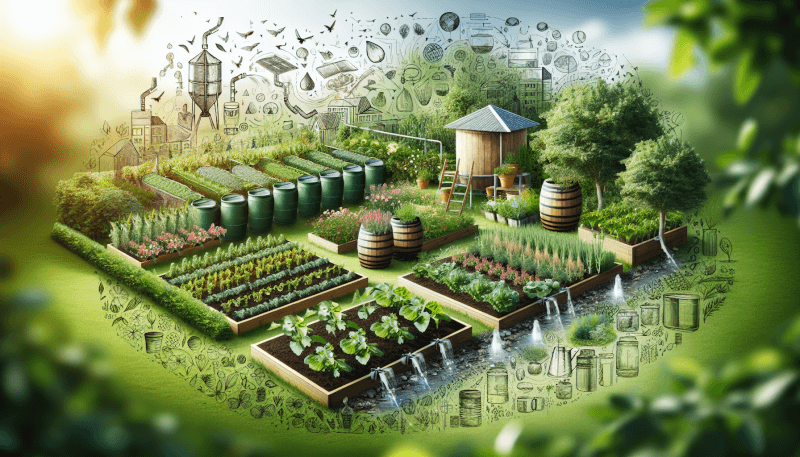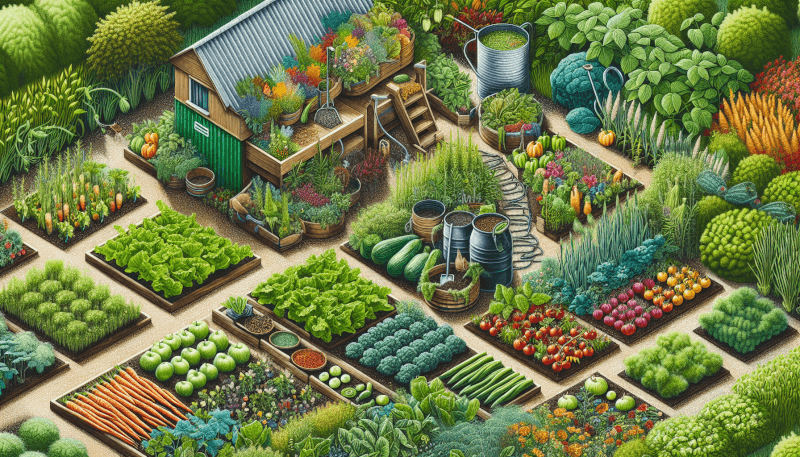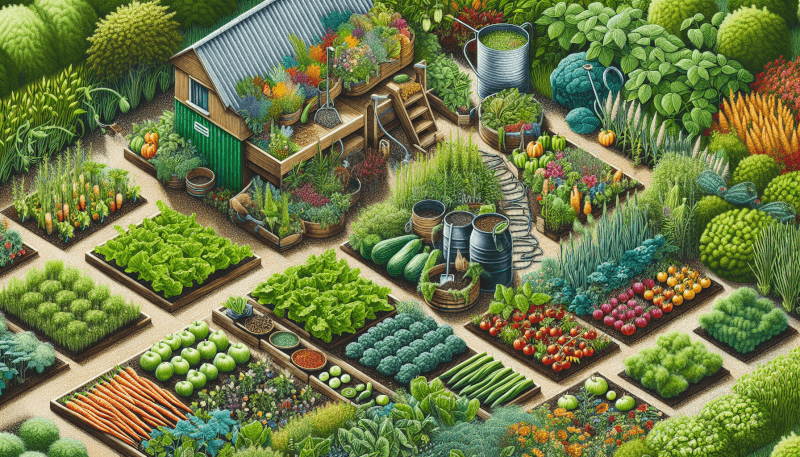Imagine stepping into your backyard and being surrounded by a lush oasis of greenery, abundant with fresh herbs, vibrant vegetables, and fragrant flowers. A sustainable and eco-friendly garden not only provides you with an endless supply of ingredients for delicious and nutritious meals but also works harmoniously with nature, minimizing your environmental impact. In this article, we will explore the essential steps and tips to create your own sustainable and eco-friendly garden, allowing you to enjoy the benefits of homegrown produce while contributing to a healthier planet. From choosing organic seeds to implementing water-saving techniques, get ready to embark on a journey towards a greener, more sustainable lifestyle.

Choosing a Location for Your Garden
Considerations for sunlight exposure
When choosing a location for your garden, it is essential to consider the amount of sunlight the area receives. Most plants require at least six hours of direct sunlight each day to thrive. Take note of the patterns of sunlight in your yard throughout the day, especially in the areas you are considering for your garden. Observe which areas receive full sun, partial sun, or shade. This will help you determine which plants will be suitable for each area and ensure that they receive the appropriate amount of sunlight for optimal growth.
Importance of soil quality
Another vital factor to consider when choosing a location for your garden is the quality of the soil. Healthy plants require nutrient-rich soil that has good drainage. Before starting your garden, it is a good idea to have your soil tested, especially if you are uncertain about its quality. Based on the results, you can then amend the soil by adding organic matter, such as compost or aged manure, to improve its fertility and structure. Additionally, avoid areas with compacted soil or areas prone to flooding, as they can hinder plant growth.
Accessibility and convenience
When planning your garden, it is important to keep accessibility and convenience in mind. You will be spending a significant amount of time in your garden, so it should be easily accessible from your house. This will make it more convenient for tasks such as watering, harvesting, and general maintenance. Consider placing your garden near a water source to minimize the hassle of dragging hoses across the yard. You may also want to allocate space for a compost pile or bin nearby for easy disposal of garden waste.
Designing Your Garden Layout
Importance of efficient use of space
Efficiently utilizing the space in your garden can significantly impact its overall productivity. Plan your garden layout to maximize the available space, considering factors such as the mature size of plants and their spacing requirements. Opt for techniques like vertical gardening or trellising for vining plants, which can help save space. Additionally, using raised beds or container gardening can be beneficial for small spaces.
Arranging plants based on their needs
Grouping plants with similar needs together can help create a more sustainable garden. Some plants require more water than others, while some thrive in full sun or shade. By strategically arranging your plants based on their needs, you can avoid overwatering or undernourishing certain plants. It will also make it easier to provide targeted care and maintenance, resulting in healthier and more vigorous plants.
Incorporating eco-friendly features
When designing your garden, consider incorporating eco-friendly features that promote sustainability. Planting native trees and shrubs can provide shade, create habitat for wildlife, and reduce the need for excessive irrigation. Installing a rain barrel or rainwater harvesting system can help conserve water resources. You can also add features like a compost bin or worm farm to recycle kitchen scraps and garden waste. These eco-friendly features not only benefit the environment but also contribute to the overall health of your garden.

Selecting Native and Organic Plants
Benefits of using native plants
Choosing native plants for your garden brings numerous benefits. Native plants are adapted to the local climate and require less maintenance once established. They are more resistant to pests and diseases, reducing the need for chemical interventions. Native plants also provide food and habitat for local wildlife, supporting biodiversity in your area. By selecting native plants, you are helping to preserve the natural ecosystem and create a harmonious environment for both plants and animals.
Choosing organic seeds and seedlings
When selecting seeds and seedlings for your garden, opt for organic varieties. Organic seeds are produced without the use of synthetic pesticides or fertilizers, ensuring that you are starting your plants off on the right foot. Organic seedlings are grown in organic soil, eliminating the risk of chemical residues. By choosing organic seeds and seedlings, you are promoting a healthier and more sustainable garden from the very beginning.
Creating a diverse ecosystem
Aim to create a diverse ecosystem in your garden by incorporating a variety of plants. Different plants attract different pollinators, such as bees, butterflies, and birds. By providing a range of flowering plants with varying bloom times, you can ensure a steady supply of food for pollinators throughout the year. This not only benefits the pollinators but also increases the chances of successful pollination for your fruit and vegetable crops. Additionally, diverse plantings can help naturally control pests by attracting beneficial insects that prey on harmful pests.
Implementing Water Conservation Techniques
Installing a rainwater harvesting system
Water conservation is a crucial aspect of sustainable gardening. Installing a rainwater harvesting system allows you to collect and store rainwater, reducing the need for municipal water sources. You can use the harvested rainwater for irrigation, reducing your reliance on treated water. Rain barrels or larger cisterns are popular options for rainwater storage. Be sure to position them near areas where you will need water the most, such as gardens or containers.
Using mulch to retain soil moisture
Mulching is an effective technique to retain soil moisture and reduce evaporation. By adding a layer of organic mulch, such as shredded leaves, straw, or wood chips, around your plants, you can create a barrier that helps to conserve moisture in the soil. Mulch also helps to suppress weeds, regulate soil temperature, and improve the overall health of the soil as it decomposes. Apply mulch to your garden beds regularly, ensuring a depth of two to three inches for optimal results.
Utilizing drip irrigation
Drip irrigation is a water-efficient alternative to traditional overhead sprinklers. It delivers water directly to the plant roots, minimizing water loss through evaporation or runoff. Drip irrigation systems can be set up using tubing with small emitters that provide a slow, steady supply of water to each plant. This method also prevents soil compaction and reduces weed growth. By utilizing drip irrigation, you can ensure that your plants receive the necessary hydration while conserving water.

Nurturing the Soil Naturally
Composting to enrich the soil
Composting is a natural way to enrich your soil and provide essential nutrients to your plants. It involves the decomposition of organic waste, such as kitchen scraps, yard trimmings, and leaves. Compost improves soil structure, enhances moisture retention, and provides a slow-release source of nutrients. Start a compost pile in your garden and regularly add kitchen scraps and plant waste. Turn the compost periodically to accelerate the decomposition process, and in time, you will have a nutrient-rich compost ready to nourish your plants.
Avoiding chemical fertilizers
Chemical fertilizers can have adverse effects on the environment and disrupt the natural balance of the soil. Instead, opt for organic fertilizers, such as compost, composted manure, or organic plant-based fertilizers. These natural options provide a slow-release of nutrients, promoting healthy plant growth without harming the environment. Organic fertilizers also improve soil fertility and help retain moisture, reducing the need for excessive watering.
Planting cover crops
Cover crops are plants that are grown specifically to improve soil health and fertility. They can prevent erosion, suppress weeds, and add organic matter to the soil when incorporated. Legume cover crops, such as clover or hairy vetch, can also fix nitrogen, making it available for other plants. Sow cover crops during periods when your garden beds would otherwise be empty, such as during the fall or winter. When it is time to plant your main crops, simply till the cover crops into the soil to enrich it naturally.
Promoting Natural Pest Control
Attracting beneficial insects
Promoting natural pest control is an essential aspect of an eco-friendly garden. Attracting beneficial insects, such as ladybugs, lacewings, and ground beetles, can help keep harmful pests in check. Planting flowers like marigolds, alyssum, and yarrow can attract these beneficial insects and provide them with nectar and pollen as alternative food sources. Additionally, providing water sources, such as shallow dishes with pebbles, can attract beneficial insects that require water for survival.
Implementing companion planting
Companion planting involves growing certain plants together to maximize their benefits and minimize pest problems. For example, planting basil near tomatoes can help deter pests like aphids and whiteflies, as basil has natural repellent properties. Similarly, planting marigolds near cucumbers can help repel pests like nematodes. By strategically pairing companion plants, you can create a natural pest control system that reduces the need for chemical interventions.
Using organic pest deterrents
Sometimes, despite your best efforts, pests may still invade your garden. In such cases, it is important to use organic pest deterrents instead of harmful chemicals. Natural options include insecticidal soaps, neem oil, and diatomaceous earth. These substances are less harmful to the environment and can effectively control common garden pests. Be sure to apply pest deterrents according to the instructions provided and avoid using them in excessive amounts to minimize any unintended consequences.

Developing a Recycling and Composting System
Setting up a proper composting system
Creating a recycling and composting system in your garden is crucial for reducing waste and enriching your soil. Set up a composting system using a compost bin or pile. You can compost kitchen scraps, yard waste, and even some paper products like shredded newspaper or cardboard. Avoid adding meat, dairy, or oily substances to your compost, as they can attract pests. Regularly turn your compost and ensure proper balance between green (nitrogen-rich) and brown (carbon-rich) materials to create a healthy composting environment.
Reducing waste through recycling
Reducing waste plays a significant role in creating a sustainable garden. Recycle materials such as plastic plant containers, cardboard, and paper. Use recycled materials when constructing garden structures or DIY projects. Repurpose household items for creative garden solutions instead of disposing of them. By embracing recycling practices, you can minimize your ecological footprint and contribute to a healthier environment.
Using compost as natural fertilizer
Once your compost has fully decomposed, it can be used as a natural fertilizer for your garden. Compost adds essential nutrients to the soil, improves its structure, and enhances microbial activity. Apply compost to your garden beds before planting or as a top dressing throughout the growing season. This will replenish the soil with organic matter, providing a sustainable and nutrient-rich environment for your plants to thrive.
Creating a Habitat for Wildlife
Providing food and water sources
Designing your garden to provide food and water sources for wildlife can help create a sustainable and eco-friendly habitat. Planting native flowers, shrubs, and trees that produce nectar, fruits, or seeds can attract birds, bees, butterflies, and other beneficial insects. Incorporate a birdbath or small pond to create a water source for wildlife. Ensure that the water is regularly refreshed to prevent the spread of diseases. By catering to the needs of wildlife, you can promote biodiversity and enjoy the presence of beautiful creatures in your garden.
Adding shelter and nesting areas
Creating shelter and nesting areas is essential for attracting wildlife. Install birdhouses or nesting boxes for birds, bat houses for bats, and bee hotels for solitary bees. Leave some areas of your garden untamed, with brush piles or fallen logs, to provide refuge for small animals and insects. These sheltered areas act as safe spaces for wildlife to rest, hide from predators, and even hibernate. Having a variety of shelter options will ensure that you attract a diverse range of wildlife to your garden.
Avoiding harmful chemicals
To create an eco-friendly habitat for wildlife, it is crucial to avoid using harmful chemicals in your garden. Pesticides and herbicides can be toxic to beneficial insects, birds, and other wildlife. Opt for organic pest control methods and embrace natural alternatives. Practice integrated pest management techniques and monitor pest populations closely to address any issues without resorting to chemicals. By avoiding harmful chemicals, you can create a safe environment for wildlife and maintain a sustainable garden ecosystem.

Utilizing Sustainable Gardening Tools and Materials
Choosing durable and long-lasting tools
Investing in high-quality, durable garden tools is a sustainable choice that reduces waste and promotes long-term use. Opt for tools made from stainless steel or carbon steel, as they are more durable and require fewer replacements over time. Choose tools with ergonomic designs that reduce strain and promote comfortable use. By investing in durable tools, you ensure that they will last for years, reducing the need for frequent replacements and minimizing your impact on the environment.
Opting for eco-friendly materials
When selecting materials for your garden, choose eco-friendly options whenever possible. Use organic mulch made from locally sourced materials instead of synthetic mulch. Opt for untreated wood or sustainably harvested wood for structures like raised beds or trellises. Consider using natural alternatives, such as bamboo or jute twine, instead of plastic ties. By opting for eco-friendly materials, you contribute to a healthier garden and a more sustainable environment.
Avoiding single-use plastics
Plastic waste is a significant environmental concern, and avoiding single-use plastics in your garden can make a positive impact. Look for alternatives to disposable plastic plant pots, such as biodegradable or reusable pots made from materials like coconut coir or recycled plastic. Use sustainable alternatives to plastic mulch, such as straw or newspaper. Choose garden supplies, such as watering cans or plant labels, made from durable materials like metal or bamboo. By reducing your reliance on single-use plastics, you help minimize plastic pollution and create a more sustainable garden.
Maintaining an Eco-friendly Garden
Regular monitoring and care
Maintaining an eco-friendly garden requires regular monitoring and care. Keep a watchful eye on your plants, checking for any signs of pests, diseases, or nutrient deficiencies. Actively remove weeds to prevent competition for nutrients and space. Regularly inspect your garden for any maintenance needs, such as repair or replacement of garden structures, watering systems, or compost bins. By staying proactive in your garden care routine, you can address issues promptly and maintain a healthy and sustainable garden.
Proper pruning and weeding techniques
Proper pruning and weeding techniques are essential for the health and vitality of your garden. Pruning helps control plant size, shape, and promotes airflow, reducing the risk of diseases. Use sharp, clean pruning shears to make precise cuts that promote healing and avoid damaging the plant. Weed regularly using hand-pulling or natural weed control methods to prevent weeds from competing with your plants for resources. By practicing proper pruning and weeding techniques, you can ensure that your garden stays healthy without relying on harmful chemicals.
Organic pest and disease management
In an eco-friendly garden, it is important to practice organic pest and disease management strategies. Regularly inspect your plants for signs of pests or diseases and intervene at the first sign of trouble. Handpick pests when possible or use natural pest deterrents like insecticidal soaps or neem oil. For fungal diseases or plant disorders, use organic fungicides or address underlying issues such as improper watering or inadequate sunlight. By focusing on prevention, early intervention, and organic methods, you can effectively manage pests and diseases while maintaining a sustainable garden.
Creating a sustainable and eco-friendly garden is a rewarding endeavor that not only benefits your health but also contributes to the overall well-being of the environment. By choosing the right location, designing an efficient layout, selecting native and organic plants, implementing water conservation techniques, nurturing the soil naturally, promoting natural pest control, developing a recycling and composting system, creating a habitat for wildlife, utilizing sustainable gardening tools and materials, and maintaining an eco-friendly garden, you can cultivate a thriving and environmentally-conscious garden for healthy recipes. So get started today and enjoy the bountiful rewards of your sustainable and eco-friendly garden!


